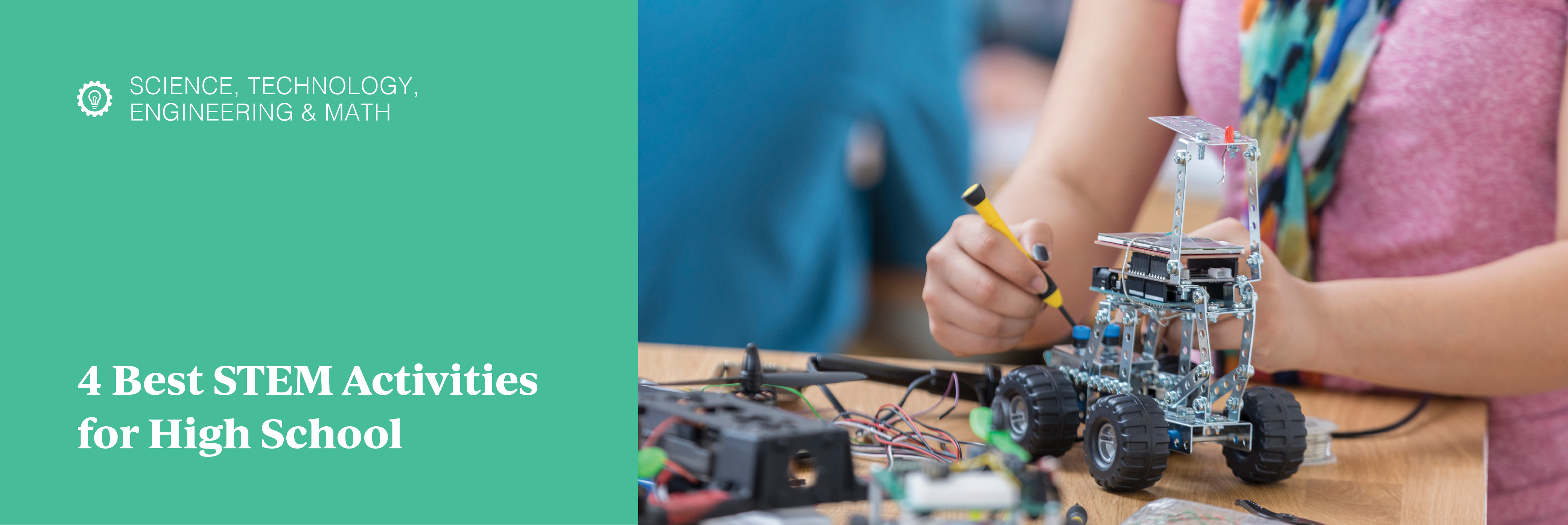4 Best STEM Activities for High School
McKenna Garrison joined the iCEV marketing team in 2022 as the Content Marketing Specialist. Originally from a small town on the Gulf of Mexico, Garrison attended Texas Tech University from which she graduated with a B.A. in Public Relations & Strategic Community and an M.A. in Mass Communication & Media Studies. Garrison looks forward to bringing more of a storytelling element to iCEV social media pages. She also hopes to connect other CTE educators from around the country to the incredible curricula and resources iCEV has to offer.
As a teacher, finding STEM activities for high school students that are both engaging and challenging can be difficult, especially with a classroom full of young learners with different needs and experience levels.
As a provider of a comprehensive STEM curriculum, teachers often ask us what hands-on activities are available and how they will push students to fully engage in their learning.
In this article, you’ll find four hands-on STEM activities for high school students that are not only challenging but also fun and engaging:
- Cardboard Automata
- Egg Drop Project
- Hour of Code
- Build a Helping Hand
When you implement one of these projects, your students will explore many different areas within STEM subjects and learn foundational principles to build their knowledge and skills and explore STEM career interests.
1. Cardboard Automata
The Cardboard Automata project from Science Buddies allows students to explore their engineering skills to create their own automata creation. An automaton is a moving mechanical device that is relatively self-operating, following a predetermined sequence of operations.
In this STEM activity, your students will create a creature that moves using only a few craft supplies. Students can have their creature move up and down, spin in circles, appear and disappear, or any combination of those movements by developing mechanisms that operate by a hand crank.
By tapping into their creative side, students can build any object they wish, truly combining their technical skills with their unique imaginations.
For this project, you’ll need a few items:
- Cardboard
- Cardboard box (an old shoebox works well)
- Cardboard tubes or toilet paper rolls
- Cardstock or paper
- Scissors or utility knife
- Tip of compass or needle
- Glue
- Drinking straw
- Skewers, at least one that is two inches longer than the shoebox
- Beads with a smooth surface
- Pencil
- Materials to color and decorate your creation
You may need additional items depending on your students' skill levels and needs, as some students may want to create more technically difficult automata using more complex driving mechanisms.
How Much Does the Cardboard Automata Activity Cost?
While the Cardboard Automata activity is free, there might be additional costs if you don’t have the supplies mentioned above.
Additionally, you could use this project as a jump start in building out your STEM classroom with potential tools and items you or your students can use for activities and projects.
However, if you’re not quite ready to build a STEM classroom, you can source the supplies you need from your classroom or other teachers in your school, have your students bring their own supplies, or purchase inexpensive materials at a local dollar store.
What Will My Students Learn from the Cardboard Automata Activity?
From conception to execution, this is a hands-on STEM activity. Students are tasked with not only researching and planning their automata but are also entrusted with building their automata while following the engineering design process.
Additionally, you can dig deeper with your class once the project is complete with follow-up questions. Some discussion questions explore how different driving mechanisms impact a creature's movements. You can also discuss different ways automata can be powered by natural resources like wind and water.
2. Egg Drop Challenge
Dare your students to the Egg Drop Challenge, a classic STEM activity for high school students that aligns with the Next Generation Science Standards (NGSS). Students will design a device to protect a raw egg and prevent it from breaking when dropped from various heights.
Due to its popularity, this high school STEM activity is almost a right of passage when learning about the engineering process, physics, and Newton’s laws of motion.
For the Egg Drop Challenge, you will need a few supplies:
- One raw egg per student or group
- Container, like a cardboard tube, cup, box, etc.
- External protection materials, like balloons, rubber bands, craft sticks, straws, etc.
- Internal padding, like fabric, packing materials, paper, etc.
- Pen or pencil
- Paper
- Tape
- Scissors
You could also let your students take a creative approach to the challenge by allowing them to bring in additional supplies from home to either make a unique device or decorate their project.
How Much Does the Egg Drop Challenge Cost?
While the Egg Drop Challenge is free, there are some supply costs associated with the project.
However, to make the challenge even more difficult, you can give your students a budget that they must work from when designing their devices. That way, the students will have to be more creative and intentional when selecting supplies, and the project can remain budget-friendly.
What Will My Students Learn from the Egg Drop Challenge?
The Egg Drop Challenge has a multitude of learning opportunities throughout the challenge.
First, students can learn about the engineering design process when researching, planning and designing their devices.
Secondly, students must consider the physics of the activity and Newton’s Laws of Motion to create a device that effectively protects the egg during the drop.
Additionally, the Egg Drop Challenge meets the following NGSS standards:
- MS-ETS1-2. Evaluate competing design solutions using a systematic process to determine how well they meet the criteria and constraints of the problem.
- MS-ETS1-4. Develop a model to generate data for iterative testing and modification of a proposed object, tool, or process such that an optimal design can be achieved.
With these learning opportunities, students will walk away from the challenge with a better understanding of STEM principles and will have built upon their foundational knowledge.
3. Hour of Code
Hour of Code is a campaign that provides a one-hour introduction to coding and programming using gamification and engaging tutorials. Created for young learners to learn the basics of a variety of coding languages, Hour of Code has lessons for different grade levels and levels of coding knowledge.
When learning about coding principles and building a knowledge base, Hour of Code suggests students practice coding for at least one hour every week. With many first-time coders, Hour of Code meets students where they are in their learning journey and introduces coding elements in a simple yet fun and engaging way.
With educators in mind, Hour of Code provides multiple resources to help you get started, including unplugged activities for those without consistent computer access, like this Color by Pixels classroom activity. Additionally, Hour of Code provides lesson plans, tutorials, and resources to encourage and support your students to continue coding.
How Much Does an Hour of Code Cost?
Created to encourage young students to learn code, Hour of Code is a completely free resource for students and teachers.
What Will My Students Learn from an Hour of Code?
Students will gain a solid understanding of coding principles and begin to hone their coding skills. Hour of Code provides lessons in a variety of coding languages, including HTML, JavaScript, Python, and CSS.
4. Build a Helping Hand
The Build a Helping Hand activity pairs anatomy and STEM engineering principles and tasks students to create hand prototypes that can perform essential functions.
One of the most overlooked machines is the human body. With the Build a Helping Hand activity, students can investigate the mechanics of the human body and how, with the help of STEM principles, it can relate to robotics or even prosthetics, marrying STEM and a multitude of other courses like health science.
The Build a Helping Hand activity encourages engineering exploration and scientific inquiry about robotic technology and requires students to think creatively about designing and building their own hands.
There are a few supplies your students will need to build a helping hand:
- Plastic drinking straws
- Needle
- String
- Paper clips
- Modeling clay
- Assorted small objects to pick up
- Scissors
- Tweezers (optional)
- Small rubber bands (optional)
- Paper towel tube (optional)
Depending on your students’ interests and the designs they create for their hands, you may need to purchase a few additional supplies.
How Much Does the Build a Helping Hand Activity Cost?
The activity itself is free, but the cost of the supplies can range from $20-$100 depending on your classroom size and which supplies you already have.
However, if you lack the funds for supplies, you can task your students with bringing in household items. You can even tap into your community of educators at your school for additional help.
What Will My Students Learn from the Build a Helping Hand Activity?
Your students will explore the engineering process and the fundamentals of robotics through this activity.
With the need to understand human anatomy, your students can also see the correlation between STEM and other subject areas. This connection allows for curiosity and interest in implementing STEM principles in other class projects and assignments.
Which High School STEM Activities Are Best for My Students?
While it can be challenging to find the perfect activity that will both pique your students' interest and push them to learn new concepts within STEM, utilizing fun and engaging hands-on activities captivates students and builds confidence in their abilities.
Whether you’re looking for a STEM activity that introduces students to a new topic like engineering principles or an activity that shows the interconnectedness between STEM and other subject areas, these activities are a great start.
However, if you need to couple your activities with a comprehensive curriculum, then consider iCEV’s STEM curriculum.
The iCEV STEM curriculum includes lesson plans, video content, assessments, engineering design projects, lab experiments, and more. In short, everything your students will need to gain practical training in essential topics while still being easy to implement and use:


